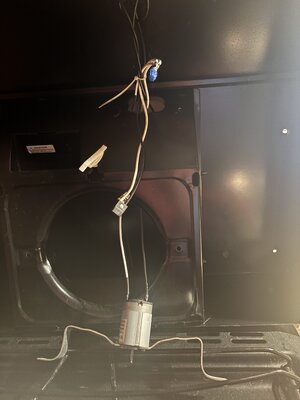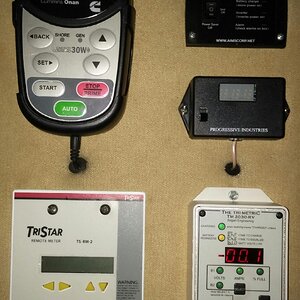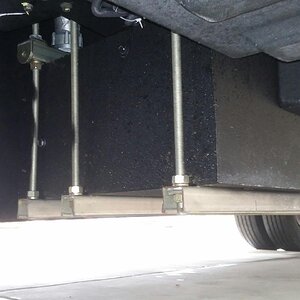Last summer, I forgot to remove the piece of plastic from vent cover that allows the oven hood to draw the heat from the camper to the outside. So, while I was boiling water the light and fan in the oven hood stopped working, which I assume is due to the amount of heat that built up.The oven hood has a sticker that says it is thermally protected. However, I removed the oven hood, and I can’t find an in-line fuse anywhere. Also, the wires running to the hood don’t have any power, however, there are no fuses blown in the fuse box. I’d love to hear some suggestions of what to do next. Thanks!
Navigation
Install the app
How to install the app on iOS
Follow along with the video below to see how to install our site as a web app on your home screen.
Note: This feature may not be available in some browsers.
More options
Style variation
Welcome to RVForums.com
- Register now and join the discussion
- Friendliest RV Community on the web
- Modern site for PC's, Phones, Tablets - no 3rd party apps required
- Ask questions, help others, review campgrounds
- Get the most out of the RV Lifestyle
- Invite everyone to RVForums.com and let's have fun
- Commercial/Vendors welcome
You are using an out of date browser. It may not display this or other websites correctly.
You should upgrade or use an alternative browser.
You should upgrade or use an alternative browser.
Hengs oven hood not working
- Thread starter Bgit
- Start date
thepopstep
RVF Regular
- Joined
- Jun 5, 2025
- Messages
- 13
- Location
- Winter Haven, Florida, United States
- RV Year
- 2025
- RV Make
- Winnebago
- RV Model
- Vista LX 29V
- RV Length
- 30 ft
Oh man, I feel this one. It’s wild how one little piece of forgotten plastic—that vent flap—can turn into a full-on troubleshooting rabbit hole. We’ve all missed something like that at least once (But now you’ve got a quiet fan, a dark light, and no sign of a blown fuse ,,,Yeah, frustrating and weirdly familiar.Last summer, I forgot to remove the piece of plastic from vent cover that allows the oven hood to draw the heat from the camper to the outside. So, while I was boiling water the light and fan in the oven hood stopped working, which I assume is due to the amount of heat that built up.The oven hood has a sticker that says it is thermally protected. However, I removed the oven hood, and I can’t find an in-line fuse anywhere. Also, the wires running to the hood don’t have any power, however, there are no fuses blown in the fuse box. I’d love to hear some suggestions of what to do next. Thanks!
You mentioned the “thermally protected” sticker, and that’s a solid clue. That phrase usually means there’s a thermal fuse or cutoff switch hidden somewhere inside. The catch? Once those trip, they don’t reset. No polite beep. No little red switch. They just stop playing the game.
And here's the kicker:
They’re often tucked away like they’re hiding from daylight! under insulation, clipped to the metal chassis, or wrapped up in shrink tubing near the motor. If you didn’t know to look for it, you'd assume it wasn’t there at all.
thepopstep
RVF Regular
- Joined
- Jun 5, 2025
- Messages
- 13
- Location
- Winter Haven, Florida, United States
- RV Year
- 2025
- RV Make
- Winnebago
- RV Model
- Vista LX 29V
- RV Length
- 30 ft
If you’ve pulled the hood and there’s zero power at the wires, but your fuse panel looks clean and happy, I’d still suggest testing upstream. Because RV wiring? It’s like playing connect-the-dots with invisible ink. Sometimes the circuit that feeds your hood shares power with an outlet or another appliance—like that one random GFCI outlet you forgot existed behind the coffee maker. Try resetting any GFCIs, even if they look fine.Last summer, I forgot to remove the piece of plastic from vent cover that allows the oven hood to draw the heat from the camper to the outside. So, while I was boiling water the light and fan in the oven hood stopped working, which I assume is due to the amount of heat that built up.The oven hood has a sticker that says it is thermally protected. However, I removed the oven hood, and I can’t find an in-line fuse anywhere. Also, the wires running to the hood don’t have any power, however, there are no fuses blown in the fuse box. I’d love to hear some suggestions of what to do next. Thanks!
Also, some manufacturers slip in inline fuses outside the main fuse box!! annoying, but it happens. They’re usually in the wiring harness, possibly wrapped in black tape. It’s not glamorous, but gently feeling along the wire for any bumps or connectors might turn something up.
Thank you both, I’m going to post a pic of the wiring leading to the hood from above the hood and the wiring below. There is a sort of rubber shrink wrap around the wires connected to the motor but unfortunately there wasn’t a fuse under it. What I’m confused about is if there is no power running to hood then the inline fuse must be before the visible wires running to the hood, but wouldn’t the inline fuse need to be inside the hood in order for it to get hot enough to shut off?


Attachments
Holdmybeer
RVF Supporter
- Joined
- Mar 8, 2023
- Messages
- 375
- RV Year
- 2016
- RV Make
- Jayco
- RV Model
- Alante 31 AL
- RV Length
- 32’
- Chassis
- F53
- Engine
- 6.8L V10
- TOW/TOAD
- Nissan Frontier Pro 4X
- Fulltimer
- No
Yes, the thermal fuse should be inside the housing. There should be an access panel. You can isolate the issue by testing your incoming line, if you've got incoming current at the range hood then you know your problem is between there and the control panel, likely then the thermal fuse which may be a disk attached to the housing or a rectangular fuse hanging loose. You could go online to the manufacturers web site. Many have a chatbot which may or may not help. The caveat there however is prepare to be frustrated, after several failed attempts the chatbot's algorithym is designed to connect you with a guy in Mumbai named Harold who will put you on hold while he calls a tech in Milwaukee, who will say "what's a thermal fuse, I work in the paint shop, but I'll ask Bob?".Thank you both, I’m going to post a pic of the wiring leading to the hood from above the hood and the wiring below. There is a sort of rubber shrink wrap around the wires connected to the motor but unfortunately there wasn’t a fuse under it. What I’m confused about is if there is no power running to hood then the inline fuse must be before the visible wires running to the hood, but wouldn’t the inline fuse need to be inside the hood in order for it to get hot enough to shut off?
View attachment 28461View attachment 28463
Thank you. My concern is that there is no current running to the hood but no fuses in the fuse box a tripped. I’ll call the manufacturer today, but I definitely don’t see anything in the hood but wires and wire nuts.Yes, the thermal fuse should be inside the housing. There should be an access panel. You can isolate the issue by testing your incoming line, if you've got incoming current at the range hood then you know your problem is between there and the control panel, likely then the thermal fuse which may be a disk attached to the housing or a rectangular fuse hanging loose. You could go online to the manufacturers web site. Many have a chatbot which may or may not help. The caveat there however is prepare to be frustrated, after several failed attempts the chatbot's algorithym is designed to connect you with a guy in Mumbai named Harold who will put you on hold while he calls a tech in Milwaukee, who will say "what's a thermal fuse, I work in the paint shop, but I'll ask Bob?".
On a side note, this happened a few years ago and I’ve just dealt with it. The only reason I’m fixing it now is because we plan to rent the camper this summer. Is it necessary to be working if I rent it?
Holdmybeer
RVF Supporter
- Joined
- Mar 8, 2023
- Messages
- 375
- RV Year
- 2016
- RV Make
- Jayco
- RV Model
- Alante 31 AL
- RV Length
- 32’
- Chassis
- F53
- Engine
- 6.8L V10
- TOW/TOAD
- Nissan Frontier Pro 4X
- Fulltimer
- No
If there's no power getting to the hood the thermal fuse in the range hood is not the culprit. I'd remove the two wires from the breaker and check for continuity. If they ohm out then you may have a faulty breaker, it's not the thermal fuse. If there's no resistance then you have a break in the line somewhere. You can further narrow it down by taking the wire nuts off at the range hood twist them together and do the same ohm test from the two wires at the panel. If that ohms out ( infinite resistance) then ohm check the other two wires leading into the hood, if they ohm out it's not the thermal fuse. If you ohm out all the way from the panel thru the hood then you likely have a breaker issue at the dist. panel.Thank you. My concern is that there is no current running to the hood but no fuses in the fuse box a tripped. I’ll call the manufacturer today, but I definitely don’t see anything in the hood but wires and wire nuts.
On a side note, this happened a few years ago and I’ve just dealt with it. The only reason I’m fixing it now is because we plan to rent the camper this summer. Is it necessary to be working if I rent it?
*just to be safe, you may want to disconnect the shore power.
Last edited:
Thank you. I checked the fuse box and there isn’t a dedicated breaker for the hood. The wiring for the hood runs under the microwave and I’m not sure where it goes after that.If there's no power getting to the hood the thermal fuse in the range hood is not the culprit. I'd remove the two wires from the breaker and check for continuity. If they ohm out then you may have a faulty breaker, it's not the thermal fuse. If there's no resistance then you have a break in the line somewhere. You can further narrow it down by taking the wire nuts off at the range hood twist them together and do the same ohm test from the two wires at the panel. If that ohms out ( infinite resistance) then ohm check the other two wires leading into the hood, if they ohm out it's not the thermal fuse. If you ohm out all the way from the panel thru the hood then you likely have a breaker issue at the dist. panel.
*just to be safe, you may want to disconnect the shore power.
Holdmybeer
RVF Supporter
- Joined
- Mar 8, 2023
- Messages
- 375
- RV Year
- 2016
- RV Make
- Jayco
- RV Model
- Alante 31 AL
- RV Length
- 32’
- Chassis
- F53
- Engine
- 6.8L V10
- TOW/TOAD
- Nissan Frontier Pro 4X
- Fulltimer
- No
It's getting 120 from somewhere, they may have tapped onto an outlet. Check the closest outlet and see, if it's a gfi, which if it's in the area of the kitchen countertops it should be and it's tripped, there could be your problem.Thank you. I checked the fuse box and there isn’t a dedicated breaker for the hood. The wiring for the hood runs under the microwave and I’m not sure where it goes after that.
I checked the GFI and it was not tripped. However, just to be safe I reset it, but that did not make a difference. I also checked all the fuses in the fuse box with a multimeter, and they were all good.
I spoke with someone at Hengs and they told me that there is an in-line fuse in the motor that would have tripped. However, there should still be power running to the hood from the fuse box. I also check the switches with a multimeter and they were good too.
I spoke with someone at Hengs and they told me that there is an in-line fuse in the motor that would have tripped. However, there should still be power running to the hood from the fuse box. I also check the switches with a multimeter and they were good too.
Boat Bum
RVF Expert
- Joined
- Aug 24, 2022
- Messages
- 534
- Location
- New Durham NH
- RV Year
- 2015
- RV Make
- Newmar
- RV Model
- Bay Star
- RV Length
- 30'
- Chassis
- F53
- Engine
- Triton V10
- TOW/TOAD
- 1983 HD FXSB Lowrider or 24 Civic
- Fulltimer
- No
Good idea, keeping my fingers crossedor bypass first?
I checked the wiring in the GFI and they not connected to the oven hood. It actually looks like the wire gauge of the wires running to the GFI are thinner.
Also, I noticed that the wires running to the hood have 1 grey/white wire and 1 white wire. Also, they appear to be a thicker gauge than what was connected to the GFI if that offers any clues. I’ll take a picture of what I’m describing
Also, I noticed that the wires running to the hood have 1 grey/white wire and 1 white wire. Also, they appear to be a thicker gauge than what was connected to the GFI if that offers any clues. I’ll take a picture of what I’m describing
Similar threads
- Replies
- 2
- Views
- 406
- Replies
- 1
- Views
- 369
Latest resources
-
-
Trueline Leveling System (Valid Air)Operation & Service Manuals for the Valid Air leveling system
- Jim
- Updated:
-
-
Notes on the Electrical Systems of the Roadtrek Zion Family of RVsNotes on the Electrical Systems of the Roadtrek Zion Family of RVs
- dilbertjth
- Updated:
-












